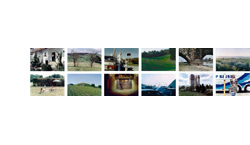Oliver Kern and Kai-Olaf Hesse
June 27 - July 31, 2009
Opening
Friday, June 26, 7-10pm
  
In different ways Oliver Kern and Kai-Olaf Hesse put an image of society up for discussion, which they both assemble and present in series of images.
In his series ‚The German Outlook’ Oliver Kern travels through Germany in various local contexts. He photographs at different times of day or season, in cloudy or sunny weather. The human being in his or her living surroundings always takes center stage and sets the standard, so to say, even if he or she is seen in rather unspectacular moments, in parking lots or in front of supermarkets. The images describe in an unhurried way a moment in time. „This, or something like this, is what Germany looks like“. It is a democratic way of photography, that takes the moment as it is.
In comparison to Kern, Kai-Olaf Hesse in his series ‚Images_in_Berlin’ doesn’t photograph people directly. Nevertheless, the human presence can be felt everywhere. Sometimes people appear indirectly, for example on posters or as sculpture. The series also comprises street scenes and a number of more or less history-charged Berlin locations. Kai-Olaf Hesse relies entirely on the aura of these places, which he approaches in various ways. At times the images are photographed through unusual perspectives, are spacially densely layered and visually complex. Other images are taken head-on and possess a clear presence.
Simplicity and complexity alternate and create a lively rhythm, that is also reflected in the presentation. Hesse organizes images in sequences of 1 to 3 images that he distributes in several axes on the bigger part of the wall. Each image shows a moment, that is self-contained and stands for itself. At the same time a new image emerges through the arrangement, allowing for additional connections and associations. Proximity and distance lead to a precarious balance between cohesion and dissolution.
Oliver Kern uses variations in the presentation of his images as well. In comparison to Hesse, however, he hangs his images closely together and in rows of 2 above one another. Through their close proximity the images are strongely correlated. A web of relationships emerges, that carries the individual images over to an overall context, where each image is of equal standing.
Petra Karadimas
|